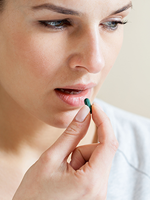Almost one third of Americans are currently considered obese.1 As the number of patients with cancer who are overweight is increasing, the conventions of chemotherapy dosing are constantly being questioned. Because of the concern for overdosing obese patients, clinicians are routinely tasked with questions such as—Should we use actual body weight, ideal body weight, or something in between? Should we cap doses? Overdosing patients is a concern for all clinicians, but underdosing may be just as problematic. Therefore, we must consider the dose-reduction questions in light of the medical literature, which suggests that such reductions may compromise patient outcomes.2-8
The use of body surface area (BSA) for dosing chemotherapy was developed in the 1950s as a method to translate animal dosing into humans,9 but no scientific study has demonstrated that BSA is a better dosing measurement than body weight or even fixed doses of chemotherapy. Many pharmacokinetic (PK) studies have demonstrated that the PK parameters do not correlate with BSA,10 and a growing body of evidence suggests that dosing obese patients based on actual body weight is not associated with increased toxicity11-14. Some have suggested that flat dosing of carboplatin based on population parameters is just as effective as dosing based on the area under the curve (AUC) calculation.15,16
In this issue of the Journal of Hematology Oncology Pharmacy, Nightingale and colleagues address the issue of dosing carboplatin in obese patients.17 This retrospective analysis involves overweight patients receiving carboplatin. The authors’ approach in this study is to look at toxicity, which is supposed to be minimized with AUC-based dosing. The conclusion that the use of actual body weight to estimate the glomerular filtration rate (GFR) is associated with high incidence of toxicity is misleading. We know the incidence of toxicity in the 20 obese patients, but normal-weight patients were excluded from this study. How can we know, then, that there would not have been a similar rate of toxicity in normal-weight patients? Of note, the 2 patients whose creatinine clearance was capped at 125 mL/min did not have toxicity. We are, therefore, left with the question of how to calculate the appropriate dose in overweight patients.
The common complaint about all studies that examine the effects of obesity on dosing is that those studies are usually retrospective, with small sample sizes, and the patient variability in PK parameters makes any generalized statement difficult. Most often, the goals of therapy are not considered. Furthermore, a little toxicity may be a good thing.18
Clinicians spend too much time worrying about doses of chemotherapy. The assumption is that because doses are individualized based on the BSA calculation or the AUC, a more accurate dose is being selected. The reality is, however, that all the dosing calculations are based on an estimate. Using the BSA consists of measured parameters (height and weight) that are then applied to a population-derived equation to arrive at an estimate. Calculating the Calvert equation for carboplatin does the same thing.19 A measured serum creatinine is used to estimate the GFR. Any additional adjustment that is then made because of obesity (or any other parameter) renders the estimate a guess.
The good news is that help may be on the way. The American Society of Clinical Oncology is in the process of developing a practice guideline for dosing chemotherapy in obese patients with cancer.20 Until then—perhaps even beyond that—clinicians will need to balance the risks versus benefits and the efficacy versus toxicity, because the answer to the question of dosing in obese patients is still not clear.
Author Disclosure Statement
Dr Soefje is on the Speaker’s Bureaus of Amgen, Eisai Pharmaceuticals, and ICU Medical, Inc.
References
- Flegal KM, Carroll MD, Ogden CL, Curtin LR. Prevalence and trends in obesity among U.S. adults, 1999-2008. JAMA. 2010;303:235-241. Epub 2010 Jan 13.
- Bonadonna G, Valagussa P, Moliterni A, et al. Adjuvant cyclophosphamide, methotrexate, and fluorouracil in node-positive breast cancer: the results of 20 years of follow-up. N Engl J Med. 1995;332:901-906.
- Bonneterre J, Roché H, Kerbrat P, et al. Epirubicin increases long-term survival in adjuvant chemotherapy of patients with poor-prognosis, node-positive, early breast cancer: 10-year follow-up results of the French Adjuvant Study Group 05 randomized trial. J Clin Oncol. 2005;23:2686-2693.
- Budman DR, Berry DA, Cirrincione CT, et al, for the Cancer and Leukemia Group B. Dose and dose intensity as determinants of outcome in the adjuvant treatment of breast cancer. J Natl Cancer Inst. 1998;90:1205-1211.
- Lepage E, Gisselbrecht C, Haioun C, et al, for the GELA (Groupe d’Etude des Lymphomes de l’Adulte). Prognostic significance of received relative dose intensity in non-Hodgkin’s lymphoma patients: application to LNH-87 protocol. Ann Oncol. 1993;4:651-656.
- Griggs JJ, Sorbero ME, Lyman GH. Undertreatment of obese women receiving breast cancer chemotherapy. Arch Intern Med. 2005;165:1267-1273.
- Mayers C, Panzarella T, Tannock IF. Analysis of the prognostic effects of inclusion in a clinical trial and of myelosuppression on survival after adjuvant chemotherapy for breast carcinoma. Cancer. 2001;91:2246-2257.
- Lyman GH. Impact of chemotherapy dose intensity on cancer patient outcomes. J Natl Compr Canc Netw. 2009;7:99-108.
- Pinkel D. The use of body surface area as a criterion of drug dosage in cancer chemotherapy. Cancer Res. 1958;18:853-856.
- Felici A, Verweij J, Sparreboom A. Dosing strategies for anticancer drugs: the good, the bad and body-surface area. Eur J Cancer. 2002;38:1677-1684.
- Lopes-Serrao MD, Gressert Ussery SM, Hall RG II, Shah SR. Evaluation of chemotherapy-induced severe myelosuppression incidence in obese patients with capped dosing. J Oncol Pract. 2011;7:13-17.
- Field KM, Kosmider S, Jefford M, et al. Chemotherapy dosing strategies in the obese, elderly and thin patients: results of a nationwide survey. J Oncol Pract. 2008;4:108-113.
- Shayne M, Culakova E, Wolff D, et al. Dose intensity and hematologic toxicity in older breast cancer patients receiving systemic chemotherapy. Cancer. 2009;115:5319-5328.
- Griggs JJ, Culakova E, Sorbero ME, et al. Social and racial differences in selection of breast cancer adjuvant chemotherapy regimens. J Clin Oncol. 2007;25:2522- 2527.
- Ekhart C, Rodenhuis S, Schellens JH, et al. Carboplatin dosing in overweight and obese patients with normal renal function, does weight matter? Cancer Chemother Pharmacol. 2009;64:115-122. Epub 2008 Nov 7.
- Ekhart C, de Jonge ME, Huitema AD, et al. Flat dosing of carboplatin is justified in adult patients with normal renal function. Clin Cancer Res. 2006;12:6502- 6508.
- Nightingale G, Trovato JA, Lee M, Thompson J. Carboplatin dosing in overweight and obese patients: a single-center experience. J Hematol Oncol Pharm. 2011;1:18-24.
- Di Maio M, Gridelli C, Gallo C, et al. Chemotherapy-induced neutropenia and treatment efficacy in advanced non–small-cell lung cancer: a pooled analysis of three randomised trials. Lancet Oncol. 2005;9:669-677.
- Calvert AH, Newell DR, Gumbrell LA, et al. Carboplatin dosage: prospective evaluation of a simple formula based on renal function. J Clin Oncol. 1989;7:1748- 1756.
- Lyman GH. Chemotherapy dosing in obese patients with cancer—the need for evidence-based clinical practice guidelines. J Oncol Pract. 2011;7:17-18.




